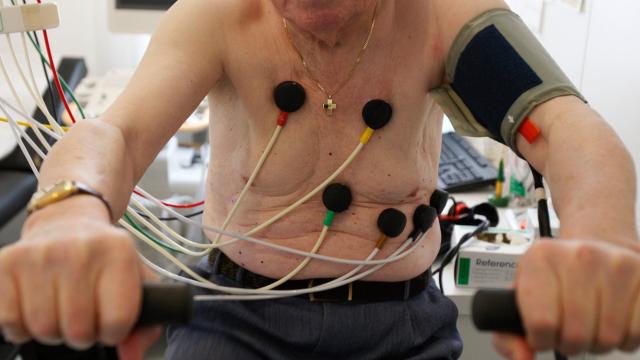Yesterday, researchers at Stanford University introduced the latest thing in AI diagnostics: An algorithm that can sift through hours of heart rhythm data gathered by wearable monitors to determine whether a patient has an irregular heartbeat, or arrhythmia. The algorithm, the researchers say, is not only as good as a cardiologist at correctly diagnosing a condition, but often better.
Image: AP Images
Humans have been envisioning a future where machines replace doctors in the diagnosing process since the 1950s, when clinical psychologist Paul Meehl put forth the controversial idea in a book with a very boring sounding name. In Clinical vs. Statistical Prediction: A Theoretical Analysis and a Review of the Evidence, he argued that simple, data-driven algorithms could make better decisions about patient diagnosis and treatment than trained clinical psychologists.
That claim went on to be replicated many times over across medicine — algorithms could, in another case, better predict cancer than radiologists. Recently, artificial intelligence and deep learning have upped the ante, promising algorithms that can not only make data-based healthcare decisions free from human error, but also process sets of data far more vast than any one human being ever could. Already on the market are deep-learning systems that assist in interpreting breast and heart imaging. Relying on image recognition, Google recently used AI to diagnose cancer faster than a human, and is testing it to diagnose diabetic blindness. The new study suggests AI might be poised to overtake doctors in yet another critical area of diagnosis — spotting irregular heartbeats that could be life-threatening.
“Any condition where data is accessible is a good next step for machine learning diagnosis,” said Pranav Rajpurkar, a graduate student in the Stanford Machine Learning Group and co-lead author of the paper, which has not been accepted for publication but is available as a pre-print on arXiv. “Eventually we see this leading to self diagnosis and increasing access to health care.”
The algorithm can detect 13 types of arrhythmia based on data from electrocardiogram signals. The researchers partnered with the heartbeat monitor company iRhythm and used the company’s massive data set collected via its wearable heartbeat monitor to train a deep neural network model on 30,000, 30-second clips from patients with arrhythmias over several months.
To test its accuracy, the researchers then pitted their algorithm against expert cardiologists to read and interpret 300 undiagnosed clips. The algorithm was just as likely to reach the consensus option as individual cardiologists, in many cases more likely.
The researchers believe that this algorithm could someday help make cardiologist-level arrhythmia diagnosis and treatment more accessible to people who are unable to see a cardiologist in person. Rajpurkar said he imagines their tool as something built into devices like iRhythm’s wearable.
In another recent study, UCSF researchers programmed an Apple Watch outfitted with a heart rate to detect a serious but often symptomless type of heart arrhythmia, atrial fibrillation, finding in a small study that it was accurate 97 per cent of the time. The vision of such work, in the end, is a sort of medical panopticon: Watches that detect heart problems, mobile phones that analyse our speech patterns for signs of Parkinson’s, an endless parade of devices to constantly monitor our state of being.
Such a future, at this point, seems inevitable. Just last year, IBM’s Watson grabbed headlines after diagnosing a 60-year-old woman’s rare form of leukaemia within 10 minutes after doctors in Japan had been stumped for months.
Rajpurkar said that in his mind, the technology won’t put doctors out of work. “The advantage is it frees up cardiologists to focus on the interaction with the patient and developing treatment,” he said.
For now, there are still limitations, though. For one, the researchers could only collect data to diagnose 13 different heart arrhythmias. For rarer forms, the data just wasn’t there.
“A lot of heart problems we’re not currently detecting,” he said. “All we need is more data.”
